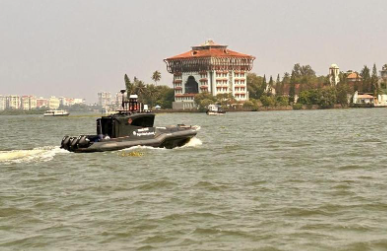India’s First Autonomous Vessel Completes 1,500-km Journey
Sagar Defence Engineering announced an important achievement. Their autonomous surface vessel completed a 1,500-kilometre journey from Mumbai to Thoothukudi without human intervention. This voyage was supported by the Indian Navy and marks a milestone in autonomous maritime technology in India.
Significance of the Journey
This journey, named ‘Sagarmala Parikrama’, showcases India’s growing expertise in unmanned systems. It marks the country’s commitment to developing advanced technologies for national security. The project is a step towards enhancing India’s defence capabilities through innovation.
Support from the Indian Navy
The Indian Navy played a crucial role in this project. They provided guidance, access to testing facilities, and operational feedback. Their support was instrumental in ensuring the success of the voyage.
Launch of the Project
The journey was virtually flagged off by Union Defence Minister Rajnath Singh on October 29, 2024. This event was part of the annual Swavlamban initiative by the Naval Innovation and Indigenisation Organisation (NIIO).
Technology Development Initiatives
The project is backed by several Indian Navy initiatives, including:
- Naval Innovation and Indigenisation Organisation (NIIO)
- Technology Development Acceleration Cell (TDAC)
- Innovations for Defence Excellence (iDEX)
These initiatives aim to promote innovation and self-reliance in defence technology.
Capabilities of the Autonomous Vessel
The autonomous vessel is designed for various missions, including Littoral patrol, Coastal surveillance, High-speed interdiction and Low-intensity maritime operations. These capabilities enhance the Indian Navy’s operational efficiency and effectiveness.
Aatmanirbharta in Defence Technology
Captain Nikunj Parashar, CEO of Sagar Defence Engineering, emphasised the importance of Aatmanirbharta, or self-reliance, in defence technology. The success of the Sagarmala Parikrama reflects India’s ability to develop autonomous systems indigenously.
Global Context
The journey aligns with global trends in autonomous maritime technology. Many countries are investing in autonomous surface and underwater systems. India is now positioning itself as a key player in this field.
The success of this voyage opens doors for future deployments of autonomous vessels. These vessels can play a vital role in critical sea lanes, enhance coastal surveillance, and assist in anti-piracy operations.
Expanding Operational Reach
The introduction of autonomous technology will expand the Indian Navy’s operational reach. It allows for more efficient monitoring of maritime activities and enhances national security.
The Sagarmala Parikrama journey is a landmark achievement for India. It demonstrates the potential of autonomous maritime systems in defence. The collaboration between Sagar Defence Engineering and the Indian Navy sets a precedent for future innovations in this field.
Month: Current Affairs - November, 2024
Category: India Nation & States Current Affairs







